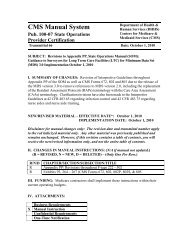2003 Louisiana Vital Statistics Report - Louisiana Department of ...
2003 Louisiana Vital Statistics Report - Louisiana Department of ...
2003 Louisiana Vital Statistics Report - Louisiana Department of ...
Create successful ePaper yourself
Turn your PDF publications into a flip-book with our unique Google optimized e-Paper software.
<strong>2003</strong> LOUISIANA VITAL STATISTICS REPORT TECHNICAL NOTES<br />
INFANT MORTALITY: a representation <strong>of</strong> deaths occurring in the first year <strong>of</strong> life. Most infant deaths are preventable. The risk<br />
<strong>of</strong> infant death is increased by giving birth at a very young age (40 years), leaving less than 2 years<br />
between births, or giving birth under conditions <strong>of</strong> poor maternal health or poor nutrition. Chemical toxins such as alcohol,<br />
drugs, and tobacco smoke also increase the risk. Most <strong>of</strong> these factors are associated with low birthweight. A newborn might<br />
be low birthweight because he/she has been compromised by one <strong>of</strong> the factors noted above or simply because he/she was<br />
born too soon (“prematurely”). After the first month <strong>of</strong> life, poor infant nutrition, poor hygiene, and infectious disease all increase<br />
the risk <strong>of</strong> infant mortality.<br />
INFANT MORTALITY RATE: a measure <strong>of</strong> deaths to infants under 1 year <strong>of</strong> age during a given period. Infant mortality rates<br />
are calculated by dividing the number <strong>of</strong> deaths to infants under 1 year <strong>of</strong> age occurring in a given population during one year by<br />
the number <strong>of</strong> live births occurring during that year, then multiplying the quotient by 1,000. The rate is expressed as the number<br />
<strong>of</strong> infant deaths per 1,000 live births.<br />
LATE ABORTION: an abortion that is performed at or after 16 weeks gestation.<br />
LIVE BIRTH: a product <strong>of</strong> conception that shows any sign <strong>of</strong> life after delivery, irrespective <strong>of</strong> the duration <strong>of</strong> pregnancy. Sign <strong>of</strong><br />
life is considered the breathing or showing any other evidence <strong>of</strong> life, such as beating <strong>of</strong> the heart, pulsation <strong>of</strong> the umbilical<br />
cord, or the definite movement <strong>of</strong> voluntary muscles, whether or not the umbilical cord has been cut or the placenta is attached.<br />
LOW BIRTHWEIGHT: a live birth weighing less than 2,500 grams (approximately 5 pounds 8 ounces). The percentage <strong>of</strong> low<br />
birthweight is the number <strong>of</strong> these births in a population during a given time interval divided by the total number <strong>of</strong> live births<br />
reported in that population during the same time interval. Low birthweight usually results from a shortened gestational period,<br />
which <strong>of</strong>ten is linked to preventable factors such as lack <strong>of</strong> prenatal care, maternal smoking, use <strong>of</strong> alcohol and other drugs, and<br />
pregnancy before the age <strong>of</strong> 18 years. Other risk factors for low birthweight include low socioeconomic level, low maternal<br />
weight gain, low pregnancy weight, first births, female sex, short maternal stature, prior low birthweight births, maternal illness,<br />
fetal infection, and a variety <strong>of</strong> metabolic and genetic disorders. Low birthweight infants are more likely than normal weight<br />
infants to have brain damage, lung and liver disease, subnormal growth, developmental problems, mild learning disorders,<br />
attention disorders, and developmental impairments. See VERY LOW BIRTHWEIGHT.<br />
MALE/FEMALE BIRTH RATIO: a measure <strong>of</strong> the number <strong>of</strong> males born for every thousand females born in a given time period.<br />
For example, a ratio <strong>of</strong> 1.036 means 1,036 males were born for every 1000 females born during a given time period.<br />
MARRIAGE RATE: a measure <strong>of</strong> marriages occurring in a population during a given period. Marriage rates are calculated by<br />
dividing the number <strong>of</strong> marriages occurring in a given population during one year by the estimated population, then multiplying<br />
the quotient by 1,000. The rate is expressed as the number <strong>of</strong> marriages per 1,000 population. The marriage rate would be<br />
more representative <strong>of</strong> resident marriages if it were calculated using the number <strong>of</strong> marriages to residents <strong>of</strong> an area, rather<br />
than the number <strong>of</strong> marriages occurring in an area. Marriage counts by residence <strong>of</strong> bride and groom are difficult to quantify,<br />
however, because couples <strong>of</strong>ten choose to obtain marriage licenses and/or to marry outside <strong>of</strong> their residence areas.<br />
MATERNAL MORTALITY: a representation <strong>of</strong> deaths <strong>of</strong> women due to complications <strong>of</strong> pregnancy and childbirth. Maternal<br />
mortality rates are calculated by dividing the number <strong>of</strong> maternal deaths in a given time period by the number <strong>of</strong> live births in that<br />
same time period, then multiplying the quotient by 100,000. Because maternal deaths occur infrequently, they are expressed as<br />
<strong>Louisiana</strong> Office <strong>of</strong> Public Health, State Center for Health <strong>Statistics</strong> Page 167
















